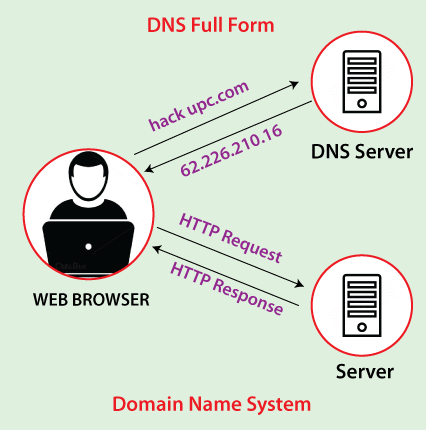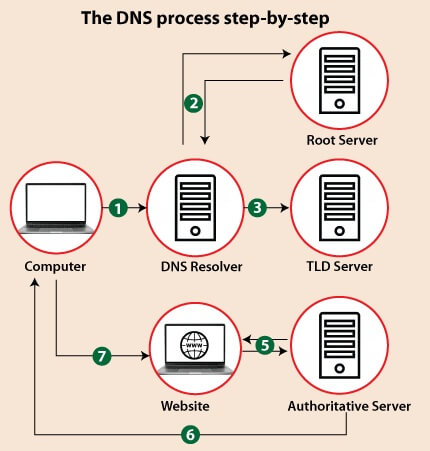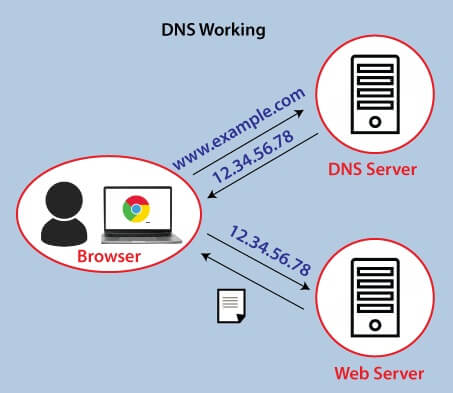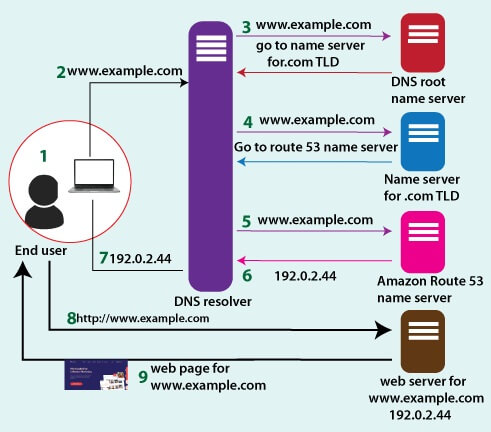Full Form of DNS
Domain Name System
DNS refers to the Domain Name System. DNS is connected to the internet. DNS is a system that is focused on a specific system that is using Internet Protocol. The entire internet system relies on the IP or the Internet Protocol address. For accessing any website, one needs the IP address. An IP address is a long numerical code, and it is not easy to remember the code.

DNS comes into the role, so DNS is that system or internet service which translates the domain name into the IP address. A domain name is in letters or alphabets. So thereby is far easier to remember than the numerical code.
For example, abcde.com is the domain name of a particular website, and with the assistance of DNS, it gets translated into an IP address, i.e., 191.123.235.6.
DNS servers are crucial and mandatory for the working of DNS. The IP address is computed with the help of the lookup table. Each system the website has its own unique IP address, which is an extended numerical code.
DNS is a form of hierarchical system that is used for computers, services, etc. DNS has been a crucial part of the Internet since 1985. DNS has the responsibility of assigning domain names, then mapping the said names by assigning name servers for each specific domain.
DNS also defines the DNS protocol – which is an extensive or detailed data structure/communication exchange that is utilised in the DNS protocol – (as a part of Internet Protocol Suite).
The Internet comprises of mainly two namespaces- Domain name Hierarchy and the Internet Protocol (IP)
The Domain Name System manages the domain name hierarchy and provides translation services.
Most common data or records saved in DNS database includes- SOA (Start of Authority); IP addresses(A and AAA), NS (Name servers); etc.
DNS has expanded over the years to save the records for other types of data as well – human inquiries, RP (responsible person record), etc.

History
ARPANET was a time when a simple, easy-to-remember name was there instead of a numerical address. Stanford Research Institute put forth that a HOSTS.TXT was used to map names to numerical addresses on the ARPANET. The assigned number list was maintained by SRI along with the ARPANET directory.
Later WHOIS directory was established in the server in SRI for retrieval of data or information relating to resources, entities, etc.
Then came the concept of domains, and it was suggested that domain should be based on the physical address or the location of the computer. Like computers at the education institute would have a domain name edu.
So, a Hosting name registry was maintained and managed from 1972-1989.
By 1980 it had become sluggish to maintain a single host table, and the upcoming network demanded an automated system to resolve the technical and personal issues.
Paul Mockapetris created a Domain Name System in 1983.
The original specifications were published in RFC 883 and 883 in 1983.
Then in 1984, Berkeley students wrote the first-ever UNIX name server for the Berkeley Internet Name Domain called as the BIND. Then in 1990, BIND was converted to the Windows NT platform.
Functioning of DNS
Domain Name System is crucial or vital as domain names are easy to remember for people. Also, computers, devices, or websites are accessed on the basis of the IP address.
Also, the working of the DNS is supported with the help of DNS servers.
When a domain name is entered in the web browser, then the request simply goes to the DNS server. The DNS server chooses the IP address by looking at the lookup table. Then through the authentic servers, information is disseminated to the user’s web browsers.

Information from all the domain servers on the internet is accumulated and stored at the Central Registry. Host companies along with the service providers regularly interact with the Central Registry in order to acquire the latest DNS information or data.
Internet Service Provider views the DNS linked with the name of the domain as the web address is entered by the user, which is then converted into machine–friendly IP address and then directed to the appropriate website with the help of the internet connection.
It takes 12-36 hours for the servers around the world to be updated and to obtain data once you register the new domain name or update the DNS server in the domain name. This time of 36 hours is known as propagation.
DNS has its own network, i.e., if one DNS server is not able to translate a specific domain name, then it can ask another server and so on the accurate IP address is found.
So a DNS server consists of a list of IP addresses along with domain names that can be retrieved when essential or mandatory.
Characteristics of DNS
DNS is essential and mandatory. There are several essential features of DNS that are responsible for the success of DNS. These include;
- DNS comprises of distributed database.
- Also, an additional or extra list of data can be reserved or stored within the DNS database.
- DNS server provides excellent features, impeccable user interface. Also, it is essential to manage certain amount of DNS through the user interface.
- DNS server is also capable of providing or serving with excellent performance and user interface.
- DNS also comprises of several other records or data or types in order to support and proper functioning of other applications- Like Mail exchanger (MX) record.
- Any sort of application that utilises the internet in order to connect from two or more hosts in order to share or disseminate information is dependent on the DNS.

DNS advantages
DNS has various advantages, including;
1. The users can receive essential or crucial messages within negligible or zero downtime.
2. In situations of maintenance or downtime, the requests are replied through the nearby node with the help of Anycast Technology.
3.DNS has the ability to quickly rectify errors and typos; it is smart.
4.DNS is a system that helps in resolving IP addresses for a specific domain name and helps in finding the website using an internet browser.
5. DNS helps in specifying technical functionality and defines DNS protocol.
6. DNS is used for load balancing or as an extra layer of security.
7.DNS can surely enhance the security of the DNS infrastructure; it is more reliable.
Disadvantages of DNS
Apart from the advantages, DNS also has various disadvantages;
1. The disintegration of DNS would lead to the destruction of WWW (World Wide Web), even if there is more than one root server or backup server. The collapse can be immensely harmful.
2.DNS root registry can be controlled by ICANN- which is a private or non-profit organisation that joins another place or country and challenged the main idea of network objectivity or neutrality
3. Spoofing of DNS can be harmful and lead to crucial data ending in the wrong hands.
4.If there is a breakdown of the server or computer, then the web- page that is hosted by the computer will not function or run or be operational.
5. DNS issues can be very difficult to handle due to disseminated location and geography.
6. Clients face a tough time connecting with the local network in the case when DNS is broken.
7. Malware can change the DNS server settings, which can result in re-direction to a new website, which might seem like original but isn’t. The said the wrong website can store your credentials, and even hackers can attack the information on your computer.
The ideal way to save you from security issues and threats is to install an anti-virus that provides protection from damage from malicious applications or programs.

Types of DNS servers
There are four types of DNS servers that are included in the process of webpage loading.
DNS recursor- This is like a librarian who is requested to search for a book in the library. This type of server is created in order to receive questions or queries from the clients through various applications. So the main responsibility of this type of recursor is to make an extra request that satisfies the queries of the clients.
Root Nameserver- This is the initial step in the translation of hostnames into IP addresses. It is like the index in the library that provides information about different stands of books, more like a reference for the other specific locations.
TLD Nameserver - TLD is also known as the Top Level Domain server. It can be known as a particular stand or shelf of the book in the library.
These are the types of DNS servers that are involved in the loading of the webpage.
This Domain Name System is a system that is very vital and crucial. In fact, the entire internet is dependent on it. It permits connection between computers and translates a specific domain name into a corresponding IP address. It is important to the maintenance, functioning, and management of the internet.